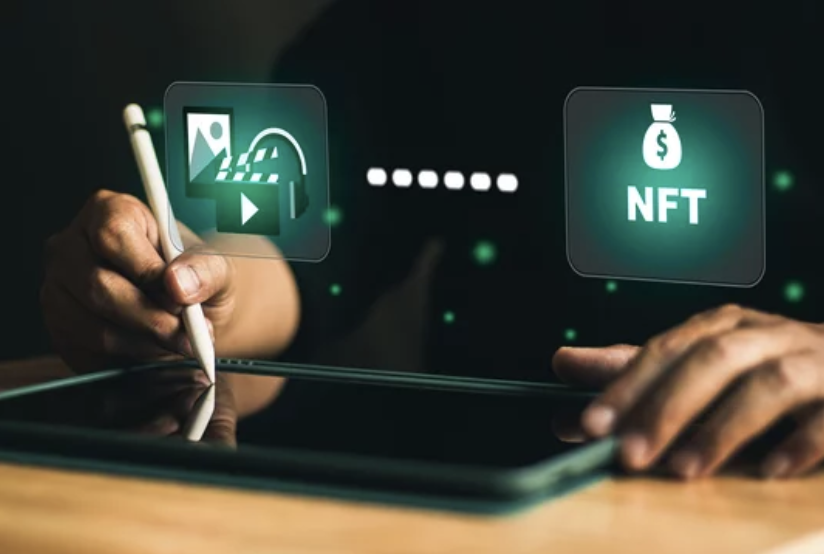
Are you ready to step into a world where a tune isn’t just a tune but a multi-dimensional experience? Where not just musicians but fans too have unprecedented control over their musical journey? Welcome to the awe-inspiring intersection of music and technology, a space that is breaking new ground and redefining what’s possible in the sonic realm.
From dusty vinyl to sleek streaming services, the music industry has always been a playground for technological innovation. Yet, what we’re witnessing now is nothing short of a digital revolution. The transition from Web 2.0 to Web 3, propelled by breakthroughs in Blockchain and the Metaverse, is rewriting the rules of the game. In this comprehensive article, we’ll explore how these futuristic technologies are not merely buzzwords but instruments of radical change for artists and audiences alike.
The Traditional Melody: Music Industry Before Web 3
For decades, the music industry has revolved around centralized systems and intermediaries. Whether it was vinyl, cassettes, CDs, or the iTunes store, the general pattern of music production, distribution, and consumption followed a one-way track from artists to the audience. And in each stage, middlemen like record labels, distributors, and retailers took their slice of the pie, often leaving artists with limited revenue and creative freedom.
Even the streaming era, heralded as the industry’s digital transformation, has its limitations. Artists still struggle to get fair compensation for their work, often earning a fraction of a penny per stream. Fans, while having access to a universe of music, often find themselves wading through an impersonal, algorithm-driven landscape.
Understanding Web 3: The New Beat
If you’re puzzled by the term “Web 3,” you’re not alone. To many, the jump from Web 2.0 to Web 3 might seem like a mere numerical increment, but it’s much more than that. While Web 2.0 was about the collaborative sharing of information, Web 3 aims to add a layer of intelligence and personalization to these interactions. But here’s the real kicker: Web 3 is fundamentally decentralized. It relies on blockchain technology to eliminate the need for central authorities or single points of failure.
So, how does this impact the music industry? Imagine a world where artists could sell directly to their audience, without any middlemen, while still maintaining secure, immutable records of ownership. Imagine a world where fans could own unique pieces of music as NFTs, transferable and sellable across the blockchain. This isn’t some far-off fantasy; artists are already minting their music as NFTs and connecting with their audiences in virtual worlds within the Metaverse.
Navigating the Blockchain: The Backbone of Innovation
Ever heard of a technology so groundbreaking that it promises to overhaul an entire industry? Well, that’s blockchain for the music world. At its core, blockchain is a distributed ledger technology, an immutable and transparent database maintained across multiple systems. This is transformative for the music industry for a multitude of reasons. For one, it replaces the need for middlemen, like record labels and streaming platforms, in validating transactions, thereby reducing the costs and barriers for both musicians and fans.
The Symphony of Smart Contracts
One of the most influential aspects of blockchain is the concept of smart contracts. These are self-executing contracts with the terms of agreement directly written into code. Imagine a musician uploading a new album to the blockchain. With smart contracts, they could easily set the rules for how this digital asset is bought, sold, or shared. This means instant and automatic royalty payments every time the music is played, purchased, or even sampled in someone else’s creation. The smart contracts eliminate misunderstandings, delays, and most importantly, unfair shares of revenue, making the entire process efficient and transparent.
NFTs: The Collectible Albums of the Future
Non-fungible tokens, or NFTs, have taken the world by storm, but how do they intersect with the music scene? Unlike cryptocurrencies such as Bitcoin or Ethereum, which are interchangeable or ‘fungible,’ NFTs are unique digital assets verified using blockchain technology. In simple terms, they’re like collectible digital cards but for almost anything digital—art, videos, and yes, music too!
Chart-Toppers in the NFT Space
To appreciate the real-world impact of NFTs on music, let’s look at some actual examples. The musician Grimes sold around $6 million worth of digital art, including music, as NFTs in just a matter of minutes. Kings of Leon released their latest album as an NFT, providing fans with exclusive audiovisual art and a VIP experience. These instances aren’t just isolated phenomena but signal a shift in how artists are approaching monetization and fan engagement. By converting their music into unique, collectible NFTs, musicians not only add a new revenue stream but also deepen their connection with fans by offering limited edition experiences that can be owned, sold, or traded.
By now, it’s becoming increasingly clear that blockchain technology and NFTs aren’t just fads but transformative tools in the music industry. Whether you’re a musician looking for equitable revenue streams or a fan searching for unique, personalized experiences, the future is not just coming; it’s already here.
Creating Your First Music NFT
Creating your first music NFT is not as intimidating as it sounds. NFTs open up an array of possibilities for monetizing your creativity and connecting with your audience on a different level. Here’s how you can go about it.
The Step-by-Step Guide to Minting Your Music NFT
- Choose a Blockchain: The first step is choosing a blockchain that supports NFTs. Ethereum is the most popular, but others like Binance Smart Chain or Tezos could also be considered.
- Set Up a Digital Wallet: You’ll need a digital wallet compatible with the chosen blockchain to store your NFTs. MetaMask is a popular choice for Ethereum.
- Fund Your Wallet: Transfer some cryptocurrency (like Ether for Ethereum blockchain) into your digital wallet to cover minting fees.
- Select an NFT Marketplace: Choose a marketplace where you’ll mint (create) and list your NFT. OpenSea, Rarible, and Mintable are good starting points.
- Create Your NFT: This is called “minting.” Upload your music file, add metadata like title, description, and price. You can also set royalties to earn a percentage every time your NFT is resold.
- List Your NFT: Once minted, you can list your NFT for sale on the marketplace. Choose whether you want a fixed price or to auction it off to the highest bidder.
Best Practices for Marketing Your NFT
Limited Editions: Creating limited editions can make your NFTs more valuable.
Social Media Teasers: Use your social platforms to tease the release of your NFT.
Engage with Community: Interact with potential buyers and fans on NFT forums and social media platforms.
Collaborations: Partner with other artists or influencers to tap into their audience.
7 Platforms Where You Can Mint Music NFTs
Navigating the world of NFT platforms can be challenging. Here’s a breakdown of the top 7 platforms where you can mint music NFTs, with features, pros, and cons for each.
OpenSea
Features: User-friendly, largest NFT marketplace
Pros: High visibility, large community
Cons: Higher fees
Rarible
Features: Community-owned, supports various types of NFTs
Pros: User voting, lower fees
Cons: Smaller audience
Mintable
Features: Gas-less minting, customizable contracts
Pros: No upfront fees, easy to use
Cons: Less popular
Foundation
Features: Curated platform, sleek design
Pros: Focus on artistic community
Cons: Need an invite to join
Zora
Features: Dynamic pricing model
Pros: Potential for higher earnings
Cons: Complicated for beginners
SuperRare
Features: High-quality art focus
Pros: Strong reputation
Cons: High fees, selective
Audius
Features: Music-focused blockchain platform
Pros: Built for musicians
Cons: Newer, less established
Entering the Metaverse: A New Concert Hall
The Metaverse isn’t just a speculative concept; it’s rapidly becoming a new frontier for musicians. This virtual, decentralized world offers a completely new kind of venue for musicians to perform in, monetize their art, and engage with fans in unique ways.
Real Stories About Rocking the Virtual Stage
Travis Scott’s Fortnite Concert: This revolutionary event saw over 12 million people attending virtually, a feat no physical venue could accomplish.
The WaveXR: This platform allows artists to perform live in a virtual space, offering exclusive VIP experiences and collectibles during events.
Decentraland Music Festival: A fully decentralized music festival featuring multiple artists and various digital experiences, from interactive games to NFT art exhibitions.
With this information, musicians are better equipped to navigate the burgeoning worlds of NFTs, blockchain, and the Metaverse. There has never been a better time to be an artist in the digital age.
The Ethical Scale of Music and Technology
As we delve deeper into the marriage of music and emerging technologies like Web 3, NFTs, and the Metaverse, ethical considerations become ever more pertinent. From the sustainability of blockchain technologies to safeguarding intellectual property rights, these issues require thoughtful deliberation.
Ethical Considerations: The Double-Edged Sword of Progress
Blockchain’s energy consumption is a significant concern, especially for platforms like Ethereum. As artists, it’s essential to weigh the carbon footprint of minting NFTs and explore greener blockchain alternatives. With this, we’re looking at a more sustainable future for the digital arts.
Intellectual Property: The New Frontier
In the world of NFTs and decentralized platforms, the question of intellectual property (IP) ownership can be murky. Smart contracts promise to make transactions transparent, but they can’t prevent IP theft. Artists must be vigilant in how they mint and distribute their work in this new landscape.
The Future: Harmonizing Ethics and Technology
The industry should aim to incorporate ethical considerations into the technology. Artists and technologists should collaborate to develop new platforms or modify existing ones to address these issues. It’s not just about what we can do; it’s about what we should do.
Some FAQs Answered About Clearing the Airwaves
Is Web 3 Secure for Musicians?
Generally, yes. Blockchain technologies are inherently more secure than their centralized counterparts. However, you should always exercise caution, particularly in how you manage your digital wallet.
How Do NFTs Affect Copyright?
Owning an NFT does not mean you own the copyright to the digital asset. The artist retains copyright unless explicitly transferred via a smart contract or other legal means.
Can Anyone Create Music NFTs?
Absolutely. The democratizing nature of Web 3 allows anyone to mint and sell NFTs. However, quality and engagement will determine success.
In Conclusion, the convergence of Web 3, NFTs, and the Metaverse is nothing short of revolutionary for the music industry. These technologies offer artists unprecedented avenues for creative expression, monetization, and engagement with fans. However, as we embrace these digital innovations, ethical considerations like sustainability and intellectual property cannot be overlooked. Now is the time for artists and fans alike to become active participants in shaping this exciting new landscape. It’s not just a technological evolution; it’s a cultural revolution.

Eric Dalius is The Executive Chairman of MuzicSwipe. Eric Dalius is also the host of the Weekly podcast program named FULL SPEED. Eric Dalius is also a philanthropist, who has established four scholarships for US based graduate & under grad students.
